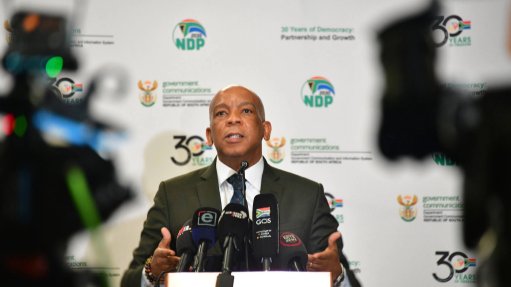South Africa must focus on logistics to have globally competitive agricultural exports - Agri SA
To be a globally competitive, agricultural produce exporting nation, South Africa needs to focus on logistics, as transport infrastructure is a crippling problem for the sector, says industry organisation Agri SA president Jaco Minnaar.
A survey done by Statistics South Africa in late 2021 revealed that only about 8% of all agricultural products were transported by rail, despite it being much cheaper than road transport. The result is excess hauler traffic on roads, with all the negative effects it causes, he points out.
The past year has been tumultuous for the agricultural sector and consecutive crises caused considerable dislocation. Further, there has been a regression in important public infrastructure, such as roads, rail and freight infrastructure, and electricity disruptions, as well as an increase in inflation that is contributing to higher borrowing costs worldwide, he notes.
Research published by the World Bank shows that, in 2020, it took about 92 hours on average to export goods from South Africa, compared with 12.7 hours in more efficient countries. Exports also cost about eight times more from South Africa than from other countries.
"Our harbours, with the same equipment as other countries, handle about a third of their volumes, according to the big shipping companies. Hence, the same report by the World Bank found that our harbours are the worst-performing of the evaluated harbours worldwide," Minnaar states.
Further, farmers and agricultural businesses have stepped in to repair rural roads to ensure goods can reach the intended markets. This removes farmers from their primary focus of producing food, and now needing to act as infrastructure maintenance agents.
The consequences stretch beyond the impact on the economy and job opportunities, as there are opportunities lost in the rural economies, emphasises Minnaar.
Horticulture, which is primarily export-oriented, experienced many problems with logistics and the current strike at transport agency Transnet is certainly not helping. These and other factors have ensured that there is a weakening in profitability in the industry, he adds.
"We have seen primary production increase from R224-billion in 2014/15 to R346-billion in 2020/21, which is about a 9%-a-year increase for this period. Comparable growth throughout the pandemic period contributed significantly to the stabilisation of the country’s economy and shielded it from the worst consequences of the sharp decline of gross domestic product in other sectors.
"With a third La Nina year in a row predicted, and local and international product prices still quite high, we expect another good production year ahead. However, a very sharp increase in input costs, challenges in export logistics and markets, Foot and Mouth disease, and various other factors could put a damper on this expectation," he notes.
Minnaar spoke during the Agri SA congress, with the theme 'Growing Local', on October 13. The theme speaks to the need for industry, partners and stakeholders to realise they can do more to ensure food security and certainty in South Africa.
"However, exports are important in the growing local debate. Exports enable the country to produce more than needed, so that we have enough to supply locally during periods of lesser production owing to factors like droughts. Surpluses to exports also help in keeping the prices of produce to remain at and below export parity, which, in turn, makes food more affordable to the local consumer.
"Maize, for example, is currently below export parity, and South African maize is one of the cheapest in the world. This has a direct effect on the price of the main staple of South Africa, namely maize meal. Linked to a proper free market price discovering mechanism and the South African farmer remaining competitive against the rest of the world, it will ensure that the South African consumer will have food certainty," he emphasises.
Exports, together with excellent local production, are the main reasons why South Africa was able to curb food price inflation compared to the rest of the world.
"According to the World Bank, in March 2022, our year-on-year food price inflation was 6.7%, compared to 7.6% in India, 11.6% in Brazil, 8.8% in the US and 9.6% in Europe. This was a relief to consumers who were already under financial strain," he highlights.
CRIME IMPACT
The worsening crime in South Africa is having devastating economic consequences because of the destruction of economic value. Proper, competent and inclusive policing, effective investigations and prosecutions processes, as well as proper punishment through the legal system is the solution to bring crime under control, Minnaar says.
The rural environment in which farmers live means that farming communities are vulnerable, which must be recognised and addressed collaboratively. It is critically important that urgent steps are taken to ensure that the police can serve rural areas and provide protection, as well as ensure that the trust of rural communities is won back.
"Crime cannot be addressed without addressing poverty and unemployment. Skills development and training are needed, as many South Africans still lack the necessary skills and productivity levels, which puts us on the back foot compared to the rest of the world," says Minnaar.
"However, global data shows that the employee cost in South Africa is affecting our competitiveness, especially in labour-intensive crops like citrus, bananas, fruit and vegetables. This shouldn’t be the case in a country with such a high unemployment rate.
"Increases in the minimum wages have made a difference in the lives of the employed, but have not helped the unemployed. Poverty in this country will not be addressed through increases in wages for those employed, but rather employment of more people to increase household income, as well as through increased efficiency," he says.
"Further, we need to protect our job-creating industries. Decisions like the relaxation of anti-dumping tariffs on chicken meat may bring short-term relief to the consumer, but, in the longer term, they cause significantly greater harm to workers, growth and development in the affected industries.
“This is not in the spirit of the recently signed Agriculture and Agroprocessing Masterplan. We cannot undermine the plan we built together before it even gets off the ground," Minnaar states.
To strengthen capacity to grow locally and compete globally, South Africa needs to lay the groundwork. Agriculture is and remains the custodian and catalyst for the economic growth and development of rural communities.
"We have to begin implementing the Masterplan with a concrete action plan, timeframes, and, most importantly, in collaboration with all stakeholders in the sector. But, we need to make sure it happens. There are still issues that need to be sorted out and refined, but we have a very good framework and strategy to work from.”
South Africa needs to expand its ability to produce surpluses so that it can play a bigger role in the export market. Higher-value export produce, like fruit, brings in foreign capital that can stimulate the local economy and create growth opportunities.
For example, the agricultural trade surplus for 2021 was about R80.4-billion. Most of this revenue flows back into rural communities where it creates jobs and provides an economical influx, Minnaar says.
Article Enquiry
Email Article
Save Article
Feedback
To advertise email advertising@creamermedia.co.za or click here
Comments
Press Office
Announcements
What's On
Subscribe to improve your user experience...
Option 1 (equivalent of R125 a month):
Receive a weekly copy of Creamer Media's Engineering News & Mining Weekly magazine
(print copy for those in South Africa and e-magazine for those outside of South Africa)
Receive daily email newsletters
Access to full search results
Access archive of magazine back copies
Access to Projects in Progress
Access to ONE Research Report of your choice in PDF format
Option 2 (equivalent of R375 a month):
All benefits from Option 1
PLUS
Access to Creamer Media's Research Channel Africa for ALL Research Reports, in PDF format, on various industrial and mining sectors
including Electricity; Water; Energy Transition; Hydrogen; Roads, Rail and Ports; Coal; Gold; Platinum; Battery Metals; etc.
Already a subscriber?
Forgotten your password?
Receive weekly copy of Creamer Media's Engineering News & Mining Weekly magazine (print copy for those in South Africa and e-magazine for those outside of South Africa)
➕
Recieve daily email newsletters
➕
Access to full search results
➕
Access archive of magazine back copies
➕
Access to Projects in Progress
➕
Access to ONE Research Report of your choice in PDF format
RESEARCH CHANNEL AFRICA
R4500 (equivalent of R375 a month)
SUBSCRIBEAll benefits from Option 1
➕
Access to Creamer Media's Research Channel Africa for ALL Research Reports on various industrial and mining sectors, in PDF format, including on:
Electricity
➕
Water
➕
Energy Transition
➕
Hydrogen
➕
Roads, Rail and Ports
➕
Coal
➕
Gold
➕
Platinum
➕
Battery Metals
➕
etc.
Receive all benefits from Option 1 or Option 2 delivered to numerous people at your company
➕
Multiple User names and Passwords for simultaneous log-ins
➕
Intranet integration access to all in your organisation


















